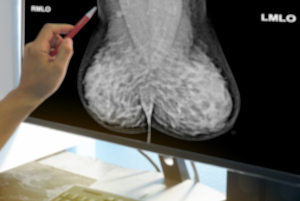by
John R. Fischer, Senior Reporter | March 25, 2022

Routine mammograms that show breast arterial calcifications could indicate a higher risk for cardiovascular disease in women.
Providers may want to consider routine mammogram findings when assessing a woman’s risk for cardiovascular disease.
Researchers at Kaiser Permanente Northern California Division of Research found that the presence of breast arterial calcifications on scans were linked to higher likelihoods for CVD in post menopausal women. This calcium build-up is found in the middle layer of the breast arterial wall. While it shows up as white areas in the arteries on a mammogram, it is not thought to be a sign of cancer but can indicate stiffening in the arteries. It is typically related to aging, Type 2 diabetes, high blood pressure and inflammation.
In their study, the authors assessed health records for more than 5,000 women. While the patients had no prior history of CVD or breast cancer, those with breast arterial calcifications were 51% more likely to develop heart disease or have a stroke. These women were also 23% more likely to develop any type of CVD, including heart disease, stroke, heart failure and diseases of the peripheral arteries.



Ad Statistics
Times Displayed: 367114
Times Visited: 7184 Quality remanufactured Certified Centrifuges at Great prices! Fully warranted and backed by a company you can trust! Call or click for a free quote today! www.Centrifugestore.com 800-457-7576
“Research has confirmed the calculators we currently use to assess an individual’s 10-year risk of developing cardiovascular disease are not as accurate in women as they are in men. In our current study, we evaluated if breast arterial calcification, which can be easily seen on a mammogram, provides more information about a woman’s risk of developing heart disease," said the study’s lead author Dr. Carlos Iribarren, a research scientist at the Kaiser Permanente Northern California Division of Research, in a statement.
Iribarren and his colleagues selected participants from over 200,000 patients who underwent mammograms as part of MINERVA (MultIethNic study of brEast aRterial calcium gradation and cardioVAscular disease), a large, racially and ethnically diverse cohort of postmenopausal women.
All had the same health insurance, were between 60 and 79 and were regularly screened annually at one of nine facilities under Kaiser Permanente of Northern California. The researchers then checked EHRs over the next 6.5 years for incidents of heart attack, stroke and other types of CVD. They found that breast arterial calcifications were more prevalent among women who identified as white or Hispanic and Latina. Black or Asian women were less likely to show signs of this calcium build-up. More research, they say, is needed to understand these variations.
Dr. Nieca Goldberg, a volunteer expert for the American Heart Association and medical director of Atria New York City, says that women may be unaware of their risk because they have not talked to their doctor about it, showed any symptoms of CVD or are not likely to get a heart evaluation for prevention. She advises them to consult their GYN's about their risk and pay attention to incidental findings of breast arterial calcification.

